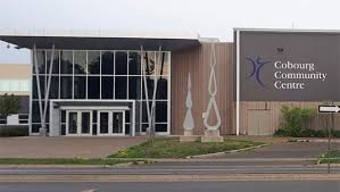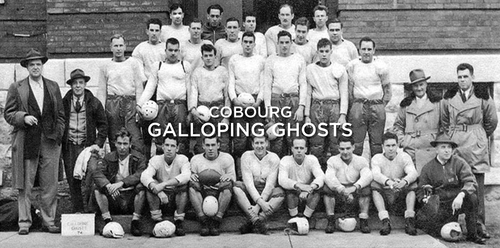Facilities-Recreation: Indoor

With athletics being a big part of this area’s heritage, facilities have developed significantly over the years.
In Cobourg, it is challenging to determine where the first hockey games were played, but it is assumed that they must have been played on the frozen ponds in the area. The first rink in Cobourg is believed to have been located at the site of the old jail, on the corner of Third and Albert Streets, from 1904-1906. In 1906, it was demolished so that the Cobourg Jail could be built. During the demolition process, part of the building collapsed and a Mr. Edward Terry was killed.
Another rink, the Corktown Quarry Rink, was established in 1938 on Water Street, in Corktown. It was on the site of a former dump and when the quarry closed, the rink was established. In 1942, a wooden building on the North side of University Avenue West, between Division and George Streets, became the Ley Brothers Arena. However, in February of 1945 the building was damaged by heavy snowfall and was deemed unsafe for use. In 1947, the Town of Cobourg held a referendum on whether to build a new “Memorial Rink”. Apparently, the referendum passed because construction on Furnace Street began in August of 1949.
The first game in the new facility was played on January 10, 1950. The new building burned down on August 17, 1953, exactly four years after construction began. It was quickly rebuilt and was re-opened on February 20, 1954. Due to the community’s high demand for ice, the “Jack Heenan Arena” (Pad 2) was built behind Memorial Arena and was officially opened on April 1, 1977. Jack Heenan had been the Mayor of Cobourg from 1961-1980.
In the spring of 2011, with the opening of the new Cobourg Community Centre, the West Northumberland Curling Club (WNCC) signed a long-term contract with the Town of Cobourg to lease the Jack Heenan Arena. The WNCC is a 5-sheet facility which offers curling to all community groups.
The Cobourg Community Centre opened in 2011, at a cost of approximately $27 million, and provides 2 ice surfaces (the Bowl & the Pond) and gym space for a wide variety of community sports and activities. It also has a running track surrounding the top of the Bowl and many rooms for small group activities/clubs.
The Rotary Waterfront Rink, with its own warm room and restrooms, was opened in 2008 and provides space for free recreational skating during the winter months. Memorial Arena was closed by the Town of Cobourg in August of 2019.
In Haldimand Township, hockey was popular by 1895 and many outdoor rinks were used for play. The first covered rink was in a building where the Catholic cemetery is now located, just south of the intersection of Aird St. and Lyle St., on the east side of the street, in Grafton. Five years later, it was closed and dismantled and residents returned to playing on the areas' frozen ponds and streams. Hockey boomed after WW1 and two more rinks were built in the 1930’s, but both were gone by the outbreak of WW2. The old sheds of St Andrew’s United Church were converted to a covered arena and flooded prior to WW2.
The current Haldimand Memorial Community Arena was completed in 1949 and officially opened in 1950. It is located west of St. George’s Anglican Church, in Grafton, on County Road #2. Surrounding the arena is a park that originally had 5 ball diamonds. However, in 2018, diamond 5 (the SW diamond) was converted to a children’s playground.
The Baltimore Community Centre is situated on 27 acres of park land, located on Community Centre Road, in Baltimore. The facility includes one ice surface with 6 dressing rooms, indoor turf sports field, banquet hall/kitchen, four ball diamonds, outdoor multi-purpose court, outdoor pickle ball court, two volleyball courts, 1.3 km paved walking trail and a picnic shelter.
Prior to 2006, the Baltimore Community Centre, constructed in 1978, consisted of a 2-level building with a hall, stage and bar upstairs and a small seating area, full commercial kitchen (operated by the Baltimore Women’s Institute), and a 2 lane bowling alley downstairs. The arena (current Sabic Arena/turf sports field) was a separate building on the site. It had been a Wintario funded project and further fundraising was required from Baltimore residents. The fundraising committee consisted of Norm Gray (chair), Eleanor Tryon (secretary), Bernice Bell, Marion Sherwin, Lloyd Baxter, Neil Cane, Howard Toyne, Ron Willis, and John Wood.
When the new facility was built, in 2006, it had two ice surfaces (the smaller Sabic Arena and the larger Lion’s Arena). In 2014 turf was installed in the Sabic Arena which was converted into an indoor turf sports field. The main ice surface is NHL size and has the capacity for more than 800 spectators.
The Bewdley Community Centre is located at 7060 Lake St., in Bewdley. The facility includes one ice surface, banquet hall/kitchen, community library, an outdoor multi-purpose court, and a ball diamond. The Bewdley Community Centre was formerly called the Vincent Massey Memorial Centre, named after Charles Vincent Massey who was a Canadian lawyer and diplomat. He was the 18th Governor General of Canada, and the first Governor General who was actually born in Canada. He retired to Batterwood House in the village of Canton, which is located near Bewdley.
The land the facility is on was originally purchased in the late 1960’s for the purpose of building a school but it was sold in 1975 to Hamilton Township for the Vincent Massey Memorial Arena. It was constructed in 1975 as a joint venture between Hamilton Township and the former Hope Township. This was a Wintario project that included fundraising from the community. In 2009, the arena was renovated to include the new hall and library and Hamilton Township took over full responsibility of the facility from Port Hope (the former Hope Township) and at that time the name was changed to Bewdley Community Centre.
In Colborne, residents recall skating at Teal’s Pond, on Parliament Street, in the 1940’s. Discussions of building an arena began in 1964. Fundraising took place and the arena was built at the site of an old train station. It was first used in 1965 on natural ice, on a sand base, with no seating, not even benches - just the ice with sand on both sides. The arena wasn’t fully completed until 1967 when they received a Centennial Grant for artificial ice.
The initial cost was only $35,000 because the land was donated and much of the labour was done by volunteers. The dressing rooms were tiny and a short time later larger dressing rooms were added to the outside of the building. Over the years, many renovations were done. The arena had wooden rafters and over the years dry rot resulted due to condensation. Annual inspections were required and in 1999 it was deemed the building would be condemned by 2001.
Colborne and Cramahe councils joined forces in 1999 and started a committee to spearhead the construction of a new arena. Committee members included interested citizens as well as some members of Cramahe and Colborne councils and staff. The committee split into 2 groups: fundraising and building. The building committee had to find land, arrange for its’ purchase, and spearhead engineer drawings for the new arena so fundraising goals could be set.
Fifty-six acres of land, where the Keeler Centre now sits, was purchased for about $250,000. Eleven acres were severed for the arena and the other forty-five acres were developed by the town into a residential subdivision. This property was originally called the “Fairgrounds” and had a racetrack on it. The Keeler Centre cost approximately 3.5 million dollars, including the cost of the land. No grant money was received so they had to take a loan, which has been fully paid off in recent years. Submissions were made from the public (contest with prize) for the naming of the arena and the winner was “The Keeler Centre”, submitted by Marion Miller, named after the founder of the village, Joseph Abbott Keeler.
The Keeler Centre opened in September of 2001 with an official opening ceremony. It is a multi-purpose facility with an ice pad and hall. Rotary Hall is equipped with a full kitchen, has a stage and complete sound system, and can accommodate up to 250 people. The Keeler Centre also has a large outdoor space – fields with electrical panels which benefits outdoor events.
The Alnwick Civic Centre is located at 9059 Country Road 45, in Roseneath. This Community Centre is perfect for large or small events, with a 400-person auditorium and a smaller 70-person community room. They are used for hosting a variety of events. The building also houses the fire department and local public library. It was opened on February 29, 1980, at a cost of $403,000 and was funded primarily through the Ministry of Housing, the Ministry of Culture and Recreation, a Wintario Grant, and generous donations from Mr. Jack VanHerwerden and Mr. Peter Feddema. The land was donated by the Roseneath Agricultural Society.
Originally, it was used for recreational activities but currently is used mainly for civic and social events. The official opening ceremonies were held on June 2, 1980, and included children planting trees which had been donated by Mr. Rapsy. A dinner followed. (Roseneath Women’s Institute: Tweedsmuir History, Mothersill Printing Inc., 1981)
There are many other specialized indoor facilities in the region that house activities such as curling, dance, gymnastics, martial arts, bowling, fitness centres, etc.
Updated August 2020



